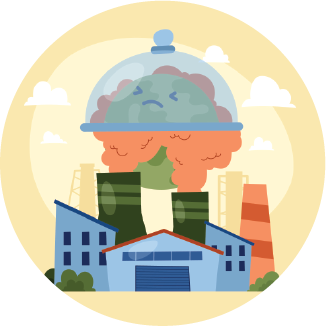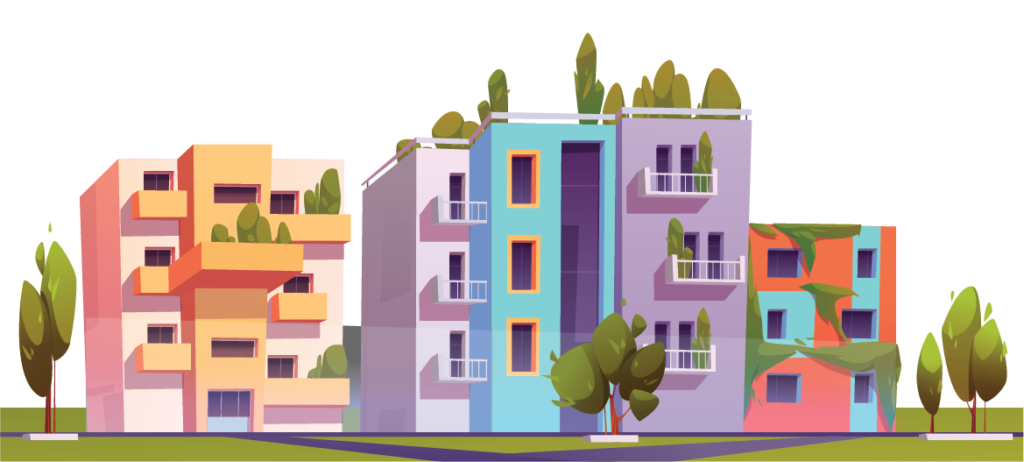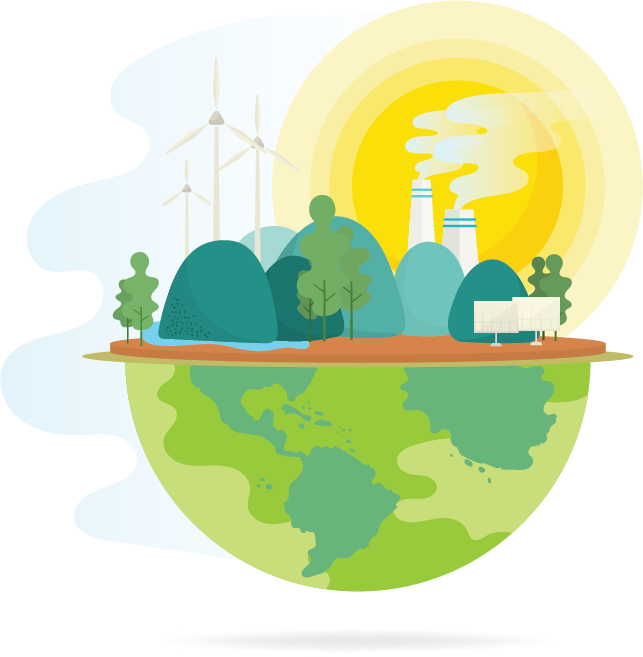Heat islands
Keep your city and your school cool!

Cities are particularly affected by climate change. Due to the large areas of sealed surfaces and dense building development, cities are more affected by rising temperatures in summer than the surrounding countryside.
BENEFITS FOR GREEN COOL SCHOOLS

- Understand the relationship between heat islands, the built environment and greening.
- Identify heat islands on school grounds or in the surrounding area.
- Find measures, in the form of “more green”, to deal with local heat islands and the effects of climate change.
- Increase understanding and awareness for “more green” at school. Where would greening help to improve the well-being of the school grounds?
Heat islands and their origin
Due to the high proportion of sealed surfaces, evaporation is reduced in cities, while at the same time the heat from solar radiation is stored on building- and street surfaces. In addition, built-up areas block the exchange of air with the cool surrounding countryside. However, it is not only the sun that heats up the city in summer, but also people with exhaust fumes from cars and waste heat from industry and also air conditions. The use of electrical appliances additionally heats up flats and houses. When these are ventilated in the evenings, the heat is released into the environment. In addition, the emission of CO2 has a negative effect on temperatures. The CO2 particles rise into the atmosphere and are stored there for over 100 years (by comparison: hydrogen only remains in the atmosphere for a few days). As a result, the sun’s rays are increasingly reflected and in turn reflected back to earth. This leads to the anthropogenic greenhouse effect.
Due to these interacting effects, heat islands are formed, which means that temperatures in the city are often up to twelve degrees Celsius higher than in the surrounding unbuilt area. This heat leads to impairments in the quality of life and well-being of the population and has health consequences, especially for vulnerable persons such as old, young or sick people.

TIP

Brainstorm with the pupils on the topic of heat in summer. How does the heat affect children and young people, and how does it affect older people? What strategies do the pupils have to cool down and escape the summer heat?
Measures to reduce heat islands
Green structures and green spaces can reduce heat storage and contribute to increasing evaporation which has a cooling effect. In addition, plants promote the decomposition of CO2 and thus clean our air in a natural way. Numerous current studies deal intensively with environmentally compatible measures that can effectively counteract heat islands. In addition to urban forests, the planting of urban trees and the design of extensive parks, the focus is on the topic of “green infrastructure”. Increasing the proportion of green spaces in urban areas by just ten percent can reduce the average air temperature by 2.5 degrees Celsius.
Green façades and roofs can alleviate temperatures in the immediate vicinity. When applied to the entire urban area, the heat island effect can be significantly counteracted. Simulations showed that temperatures in street canyons between green façades can be reduced by 4.5 degrees Celsius in Mediterranean climates or by 2.6 degrees Celsius in temperate climates.
By securing open spaces or fresh air corridors, the transport of cold air in cities can also be promoted. However, this requires long-term urban planning.

DID YOU KNOW?

Façades and roofs as green space potential!
Green spaces in urban areas have already become scarce due to the expansion of transport infrastructures and the continual construction of new buildings. Greening of buildings, such as roof or façade greening, is a good way to compensate for these lost green zones at least partially in the city. In a direct comparison of areas, vertical surfaces have more potential for greening measures on buildings than on roofs. In the case of high-rise buildings, this is multiplied. In the case of roof surfaces, flat roofs and low-sloping roofs with an inclination of up to 20 degrees are particularly well-suited for greening. Façades and roofs thus offer a potential for the greening of heavily sealed urban areas that is often still untapped.
What does “microclimate” mean?
The term “microclimate” refers to the area up to two metres above the ground and the air layers within it. The microclimate forms in a clearly defined area (e.g., between buildings in a city). It is characterised by ground friction and, above all, by large temperature differences. People, plants and animals are directly exposed to the microclimate. Especially in cities, the microclimate can deviate greatly from the regionally typical climate due to the buildings and sealed surfaces.
What is the greenhouse effect?
The natural greenhouse effect ensures that the earth has a pleasant 15 degrees Celsius instead of -18 degrees Celsius on average. On the earth’s surface, part of the sunlight is converted into heat. The gases naturally occurring in the atmosphere, methane (CH4), carbon dioxide (CO2) and water vapour (H2O), slow down the radiation of this heat into space, thus acting like a greenhouse. Fossil fuel combustion and large-scale agricultural operations release additional carbon dioxide, hydrocarbons (CmHn) and ozone (O3) into the atmosphere. They trap even more of the heat radiation in the atmosphere and thus warm up the earth even more. This phenomenon is called the anthropogenic, or manmade, greenhouse effect.

DID YOU KNOW?

Climate and soils
Soils and climate exist in a dynamic equilibrium and influence each other. The climate is largely responsible for the formation of the soil. Healthy and intact soils in turn have an influence on the climate by absorbing and binding carbon and other greenhouse gases from the atmosphere. Soils as carbon reservoirs can thus counteract global warming or the greenhouse effect.
Did you know that oceans are like lungs for the earth?
Large amounts of CO2 are absorbed by diatoms and calcareous algae – also called phytoplankton – in the ocean and converted into oxygen through photosynthesis.
OPPORTUNITIES TO DEEPEN THE TOPIC ACROSS DISCIPLINES

As an interdisciplinary consolidation you can work on the following questions with the pupils:
What influence does the microclimate have on the pupils?
- The pupils describe the term microclimate and apply it to their own living environment and the school environment.
- They describe the characteristics to be found.
What characterises an ideal urban climate?
- Discuss together the characteristics of an ideal city climate and compare those with cities known to the pupils.
- In physics lessons, you can discuss absorption and the greenhouse gas effect.
- In history lessons, for example, talk about how the level of pollutants in the atmosphere has changed due to industrialisation.
Experiments
Experiment: Measuring temperatures and surface temperatures
In this practical example, the pupils measure the temperatures at different locations. In this way, they observe at close range what influence materials, green spaces, plants and water have on our microclimate.


